Table of content
Daikon radish, a crisp and mildly peppery root vegetable, is a staple in kitchens across Asia, Europe, and beyond. Often overlooked in Western cuisine, this versatile ingredient boasts a refreshing texture and a subtle flavor that lends itself to countless cooking methods. Whether you’re a seasoned chef or a home cook looking to expand your repertoire, mastering the art of preparing daikon can elevate your meals with minimal effort. This article explores the nuances of selecting, preparing, and cooking daikon radish to perfection, ensuring every bite is a delightful balance of flavor and texture.
Understanding Daikon Radish: A Brief Overview
Daikon (Raphanus sativus var. longipinnatus), also known as white radish, Japanese radish, or Chinese radish, is a winter vegetable celebrated for its crispness and adaptability. Unlike its spicier red or black cousins, daikon offers a mild, slightly sweet taste with a hint of peppery zing when raw. Its high water content (about 95%) makes it hydrating, while its low-calorie profile and rich supply of vitamins C, B6, and minerals like potassium and magnesium render it a nutritious addition to any diet.
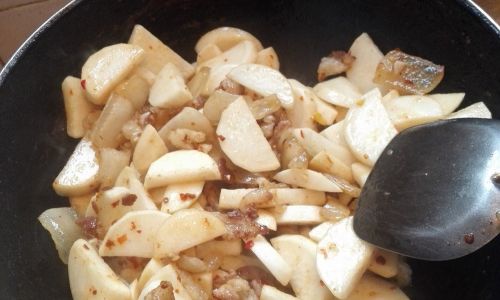
The vegetable’s versatility stems from its ability to absorb flavors while retaining its characteristic crunch. From salads and slaws to soups, stews, and stir-fries, daikon’s culinary applications are limited only by imagination. However, achieving the perfect balance of tenderness and crispness requires understanding the nuances of cooking techniques.
Selecting and Storing Daikon Radish
Before diving into recipes, it’s essential to choose a high-quality daikon. Look for firm, unblemished roots with smooth, glossy skin. Avoid specimens with soft spots, cracks, or a rubbery texture, as these indicate age or improper storage. The greens, if attached, should be vibrant and fresh—a sign of recent harvesting.
Storage is equally critical. Store unwashed daikon in a plastic bag in the refrigerator’s crisper drawer, where it can last up to two weeks. For longer preservation, consider pickling or fermenting—methods we’ll explore later.
Preparation: Peeling, Slicing, and Beyond
Preparing daikon begins with a thorough wash under cool water to remove dirt. While peeling is optional, many prefer to remove the outer skin, especially if the daikon is mature or has a thick, fibrous layer. Use a sharp knife or vegetable peeler for precision, taking care not to waste excess flesh.
The way you cut daikon affects cooking time and texture. For stir-fries or quick sautés, julienne the radish into thin, even strips. For braises or soups, larger chunks or half-moons work best. Grating daikon yields a delicate, snow-like texture ideal for salads or garnishes. Experiment with shapes to discover your preference.
Cooking Methods: From Crisp to Tender
Stir-Frying: Preserving Crunch and Color
Stir-frying is perhaps the quickest way to cook daikon, retaining its vibrant color and satisfying crunch. The key lies in high heat and rapid cooking to prevent sogginess.
Ingredients:
- 1 medium daikon radish (about 1 lb.), peeled and julienned
- 2 tbsp vegetable oil
- 2 garlic cloves, minced
- 1 tbsp fresh ginger, grated
- 1 tbsp soy sauce (or tamari for gluten-free)
- 1 tsp sesame oil
- Salt and pepper to taste
- Optional: 1 red bell pepper, sliced; 1/4 cup cashews
Instructions:
- Heat the oil in a wok or large skillet over high heat until shimmering.
- Add garlic and ginger, stirring for 30 seconds until fragrant.
- Toss in the daikon and bell pepper (if using). Stir-fry for 3–4 minutes, ensuring the vegetables are evenly coated.
- Drizzle with soy sauce and sesame oil. Cook for another minute, adjusting seasoning as needed.
- Serve immediately, garnished with cashews.
Pro Tip: Overcooking daikon in stir-fries leads to mushiness. Aim for a tender-crisp texture by testing with a fork—it should yield slightly but retain resistance.
Braising: Melding Flavors for Depth
Braising transforms daikon into a melt-in-your-mouth delight, absorbing the flavors of aromatic broths or sauces. This method is ideal for heartier dishes, pairing daikon with proteins like pork belly or tofu.
Ingredients:
- 1 large daikon, peeled and cut into 1-inch thick rounds
- 2 cups dashi (Japanese soup stock) or vegetable broth
- 1/4 cup mirin (sweet rice wine)
- 2 tbsp soy sauce
- 1 tbsp sugar
- 1 tbsp vegetable oil
- 1 onion, sliced
- 2 garlic cloves, smashed
Instructions:
- In a deep skillet, heat oil over medium heat. Sauté onion and garlic until golden.
- Add daikon rounds, arranging them in a single layer. Pour in dashi, mirin, soy sauce, and sugar.
- Bring to a simmer, then reduce heat to low. Cover and braise for 25–30 minutes, flipping halfway, until daikon is tender and glossy.
- Remove lid, increase heat to medium-high, and reduce the sauce until syrupy.
- Serve with steamed rice, spooning the reduced sauce over the daikon.
Variation: For a Korean twist, substitute dashi with anchovy broth and add gochujang (chili paste) for spice.
Roasting: Caramelizing Natural Sugars
Roasting daikon concentrates its natural sugars, yielding a caramelized exterior and creamy interior. This technique is surprisingly underutilized but delivers exceptional results.
Ingredients:
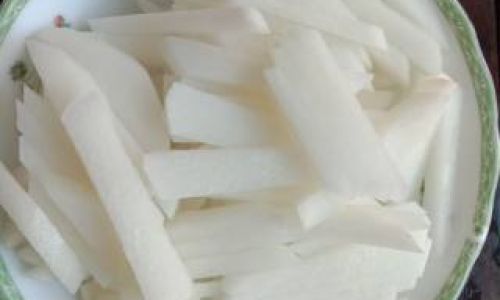
- 2 lbs. daikon, peeled and cut into 1/2-inch wedges
- 3 tbsp olive oil
- 1 tsp smoked paprika
- 1 tsp honey or maple syrup
- 1/2 tsp salt
- 1/4 tsp black pepper
- Fresh thyme or rosemary for garnish
Instructions:
- Preheat oven to 400°F (200°C). Toss daikon wedges with olive oil, paprika, honey, salt, and pepper.
- Spread in a single layer on a baking sheet. Roast for 30–35 minutes, flipping halfway, until golden and tender.
- Garnish with herbs and serve as a side dish or atop salads.
Pro Tip: For extra crispiness, broil for 2–3 minutes at the end, watching closely to prevent burning.
Pickling: Preserving Freshness for Months
Pickled daikon is a pantry staple in many cultures, offering a tangy, crunchy accompaniment to rice bowls, sandwiches, and grilled meats. Quick-pickling and fermentation are two popular methods.
Quick-Pickled Daikon:
- 1 lb. daikon, julienned
- 1 cup rice vinegar
- 1/2 cup sugar
- 1 tbsp salt
- 1 tsp red pepper flakes (optional)
- Combine vinegar, sugar, salt, and pepper flakes in a saucepan. Bring to a simmer until sugar dissolves.
- Pack daikon into sterilized jars. Pour hot brine over, ensuring full submersion.
- Seal and cool. Refrigerate for at least 24 hours before serving.
Fermented Daikon (Korean Kkakdugi):
- 3 lbs. daikon, peeled and cubed
- 1/4 cup sea salt
- 2 tbsp Korean chili flakes (gochugaru)
- 1 tbsp minced garlic
- 1 tbsp grated ginger
- 1 tbsp sugar
- 1/4 cup fish sauce (optional)
- Toss daikon with salt and let sit for 1 hour. Rinse and drain.
- Mix with chili flakes, garlic, ginger, sugar, and fish sauce.
- Pack into a sterilized jar, leaving 1 inch of headspace. Press down to submerge in brine.
- Ferment at room temperature for 3–5 days, burping daily to release gases. Refrigerate once desired tanginess is achieved.
Soups and Stews: Infusing Broths with Subtle Sweetness
Daikon’s ability to soften without disintegrating makes it a stellar addition to soups and stews. In Japanese cuisine, it’s a key ingredient in oden (a winter stew), while in Vietnamese canh củ cải, it’s simmered with pork ribs for a comforting broth.
Daikon and Pork Soup:
- 1 lb. daikon, peeled and thickly sliced
- 1 lb. pork shoulder, cubed
- 8 cups chicken broth
- 4 garlic cloves, smashed
- 2-inch ginger, sliced
- 2 tbsp fish sauce
- 1 tbsp soy sauce
- 1 bunch cilantro, chopped
- In a large pot, brown pork over medium-high heat. Add garlic and ginger, sautéing for 2 minutes.
- Pour in broth, fish sauce, and soy sauce. Bring to a boil, then reduce to a simmer.
- Add daikon and cook for 45–60 minutes until pork is tender.
- Serve with cilantro and steamed rice.
Pro Tip: For a clearer broth, skim off impurities during the initial simmer.
Enhancing Flavor: Complementary Ingredients and Seasonings
Daikon’s mild flavor acts as a canvas for bold seasonings. Experiment with:
- Aromatics: Garlic, ginger, shallots, and lemongrass.
- Umami Boosters: Soy sauce, miso, fish sauce, and dried mushrooms.
- Herbs and Spices: Cilantro, mint, dill, sesame seeds, and black pepper.
- Acids: Rice vinegar, lime juice, and yuzu.
Pair daikon with proteins like pork, beef, or tofu, or contrast its crunch with soft ingredients like silken tofu or avocado.
Common Mistakes to Avoid
- Overcooking: Daikon turns mushy if simmered too long. Test doneness with a fork.
- Under-Seasoning: Its mild taste requires adequate salt, acid, or umami.
- Inconsistent Cuts: Uneven slicing leads to uneven cooking. Use a mandoline or sharp knife for precision.
- Ignoring Bitterness: Some daikons have a slight bitterness. Blanch in salted water for 2 minutes before cooking to mitigate.
Cultural Significance and Creative Uses
Daikon’s culinary journey spans continents. In Japan, daikon oroshi (grated daikon) is a classic condiment for grilled meats. In India, it’s pickled as mooli ka achar, while in Russia, it’s used in hearty stews. Modern chefs are now incorporating daikon into vegan sushi rolls, crispy fries, and even daikon “noodles” as a low-carb alternative.
Conclusion: Elevating Daikon from Ordinary to Extraordinary
Daikon radish, once relegated to crudité platters, deserves a place of honor in your kitchen. By mastering techniques like stir-frying, braising, roasting, and pickling, you can transform this humble root into dishes that surprise and delight. Whether you’re seeking a quick weekday side or a showstopping centerpiece, daikon’s adaptability ensures it’s always up to the task.
Next time you spot a plump daikon at the market, seize the opportunity to experiment. Let its crisp texture and subtle sweetness inspire creativity, and soon, you’ll wonder how you ever cooked without it. Bon appétit!
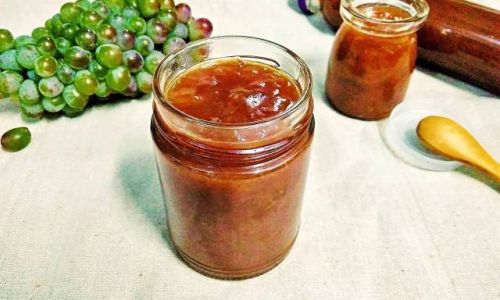

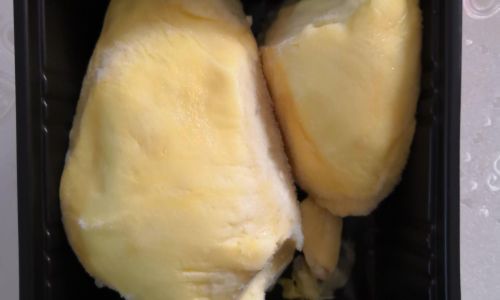
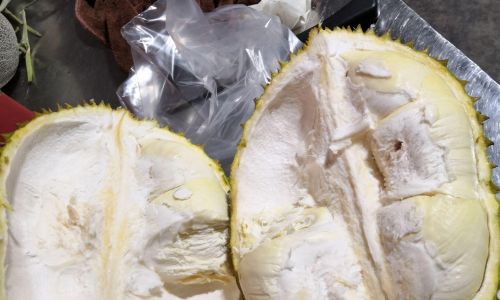

0 comments